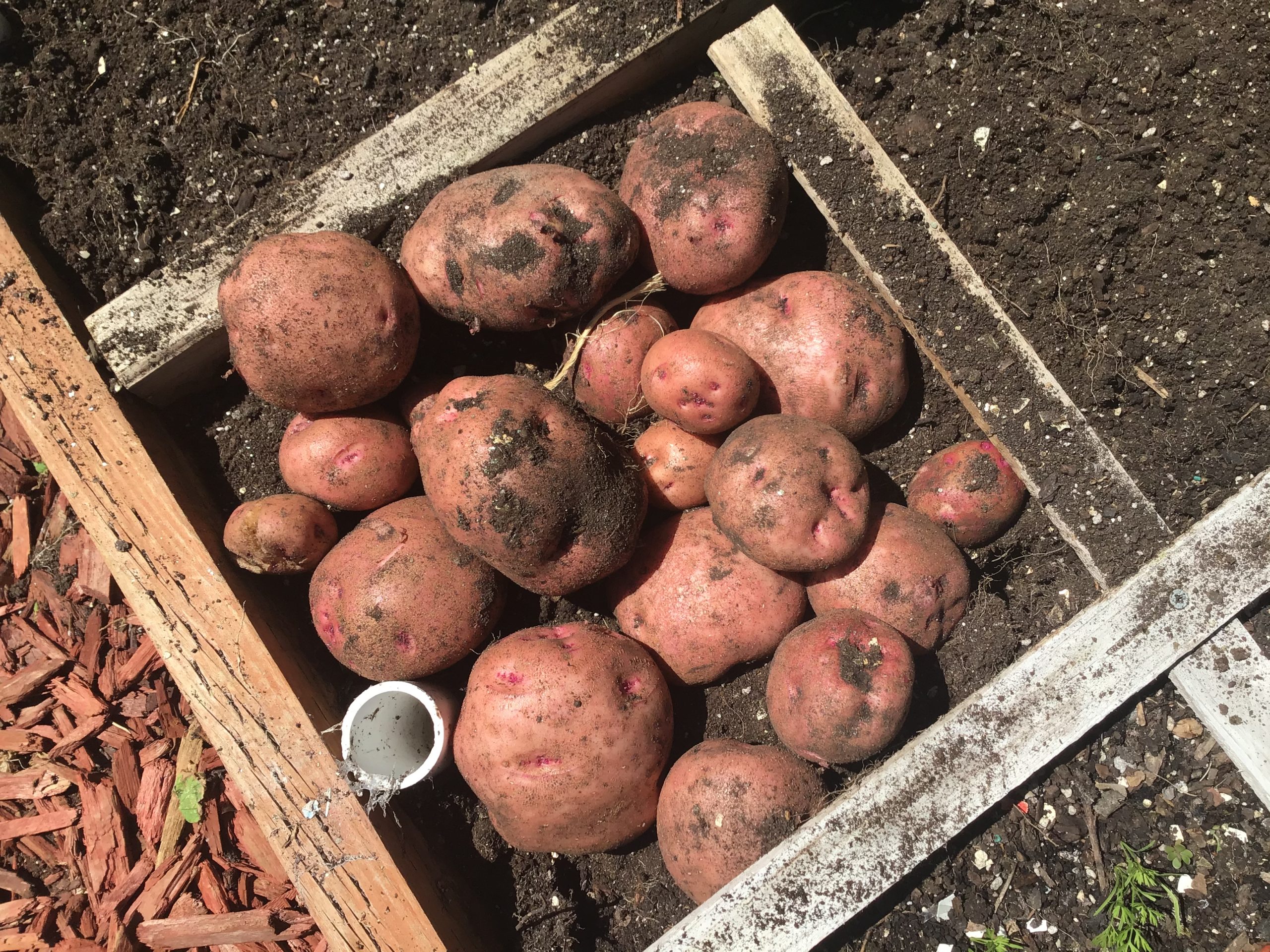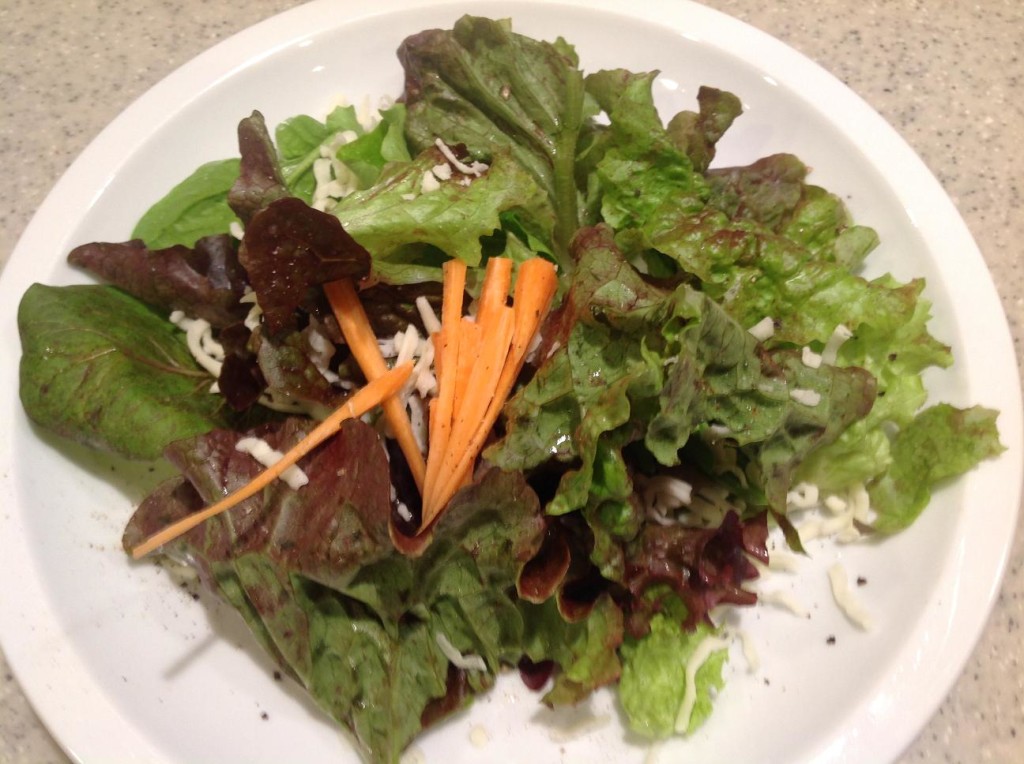 It’s a great mesclun mix of red sails and allstar lettuce, radicchio, butter chard, and spinach. I’m a little surprised at the spinach this late in the season after two harvests already. It’s grown back very nicely and we’ve got at least enough for another week. Top it off with some minicor carrots, mozzarella cheese, freshly grated pepper, and then a nice vinaigrette. My entire summer garden is almost completely planted. I’ve left a few squares open for a second planting of zucchini and for summer lettuce. But I’ll soon be emptying out squares of red ace beets, spinach, radicchio, and carrots. This should leave me plenty of open squares for my summer lettuce-which are the greatest to go along with those vine-ripened tomatoes. All my herbs are in-rosemary, cilantro, chives, parsley, garlic, and basil. And I’ve just planted 2 additional squares of red pontiac potatoes. Now’s the time to put your entire summer garden in for zone 6. Tomatoes, peppers, squash, zucchini, corn, all your herbs, chard, lettuce varieties, beets, beans, scallions. And then get ready for a great harvest in a few weeks.[ois skin=”below post”]
It’s a great mesclun mix of red sails and allstar lettuce, radicchio, butter chard, and spinach. I’m a little surprised at the spinach this late in the season after two harvests already. It’s grown back very nicely and we’ve got at least enough for another week. Top it off with some minicor carrots, mozzarella cheese, freshly grated pepper, and then a nice vinaigrette. My entire summer garden is almost completely planted. I’ve left a few squares open for a second planting of zucchini and for summer lettuce. But I’ll soon be emptying out squares of red ace beets, spinach, radicchio, and carrots. This should leave me plenty of open squares for my summer lettuce-which are the greatest to go along with those vine-ripened tomatoes. All my herbs are in-rosemary, cilantro, chives, parsley, garlic, and basil. And I’ve just planted 2 additional squares of red pontiac potatoes. Now’s the time to put your entire summer garden in for zone 6. Tomatoes, peppers, squash, zucchini, corn, all your herbs, chard, lettuce varieties, beets, beans, scallions. And then get ready for a great harvest in a few weeks.[ois skin=”below post”]
Monthly Archives: May 2014
Much planted, much to go
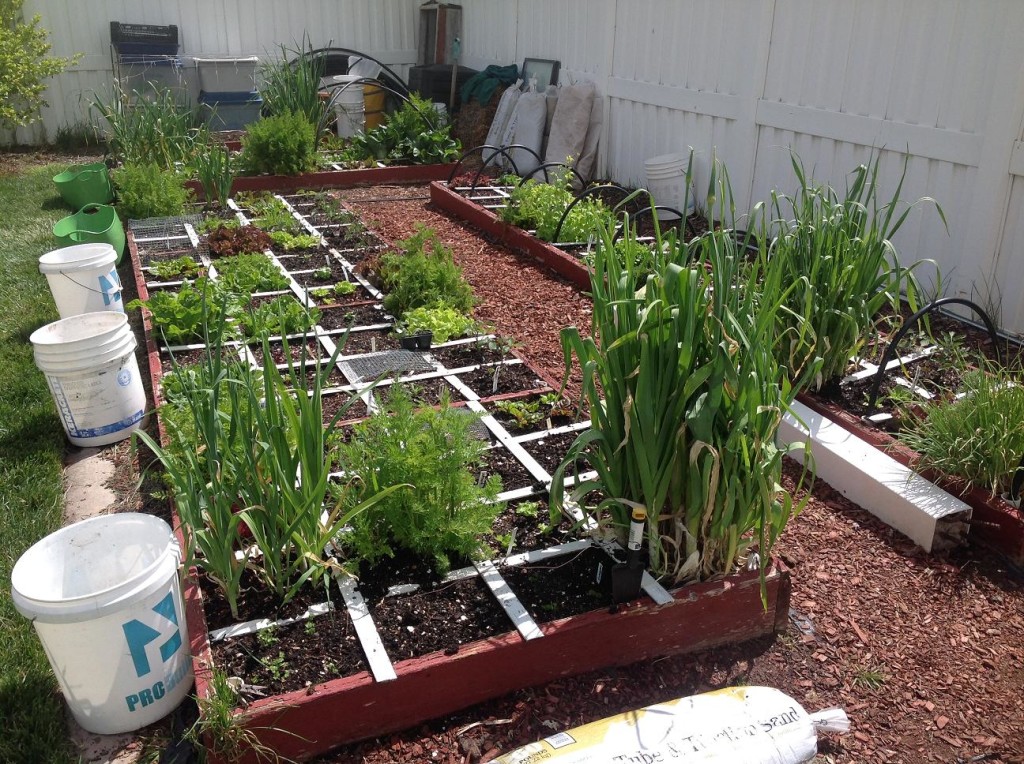 After tomorrow I’ll have a lot of newly emptied squares. To date I have a lot of the summer crops in and growing. Tomatoes, cucumbers, summer lettuce varieties, chives, carrots, chard, scallions, potatoes, nasturtium, peppers, basil, and bush beans are all in. In the next day I’ll finish planting all the rest-zucchini, patty pan and banana/butternut squash, beets, scallions, and maybe some thyme. I’ll continue to plant lettuce all summer long to make sure I have a large enough harvest by the time the tomatoes ripen. If you’re looking for a nifty little gadget to tell you what to plant and when, you ought to check this out. It’s free and easy to use. You’ll get an email periodically to remind you what to plant next. Read about it here. Hope this helps out.
After tomorrow I’ll have a lot of newly emptied squares. To date I have a lot of the summer crops in and growing. Tomatoes, cucumbers, summer lettuce varieties, chives, carrots, chard, scallions, potatoes, nasturtium, peppers, basil, and bush beans are all in. In the next day I’ll finish planting all the rest-zucchini, patty pan and banana/butternut squash, beets, scallions, and maybe some thyme. I’ll continue to plant lettuce all summer long to make sure I have a large enough harvest by the time the tomatoes ripen. If you’re looking for a nifty little gadget to tell you what to plant and when, you ought to check this out. It’s free and easy to use. You’ll get an email periodically to remind you what to plant next. Read about it here. Hope this helps out.
[ois skin=”below post”]
Cut-and-come again lettuce
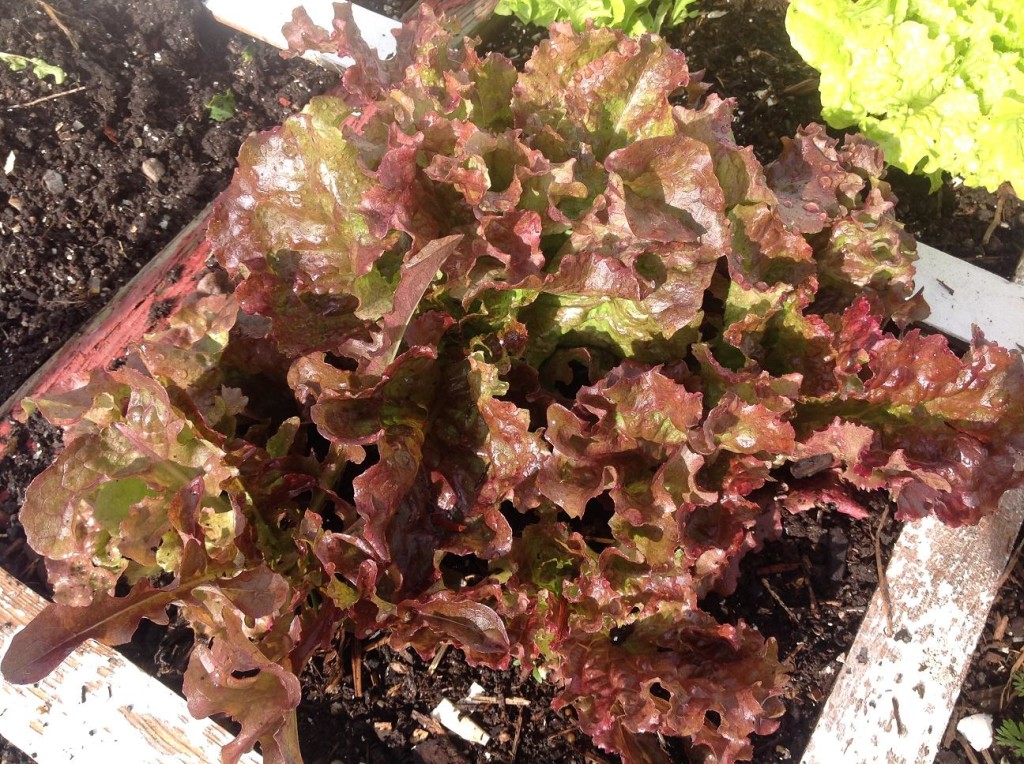 I have a new ebook coming out soon about lettuce and how to grow it in warm weather. I talk about using several techniques to be successful in doing so. One of those techniques is to use a cut-and-come again or loose leaf lettuce variety. Granted this isn’t the hot part of the season but your lettuce should behave just like this picture. Tomorrow I will be cutting this for the 3rd time. I started it in the winter and it’s still going. So far it’s grown back to this size in 3 weeks. I have many squares of this type of lettuce growing right now in my garden but this will become increasingly important in the next 8 weeks. Just cut it right above the crown of the plant and you’ll harvest it two more times after the initial cut. This is Red Sails-a readily available variety. Keep an eye out for my ebook-it will hopefully get here before the hot weather. It will be available on Amazon, my blog, and possibly the Square Foot Gardening Foundation as well.
I have a new ebook coming out soon about lettuce and how to grow it in warm weather. I talk about using several techniques to be successful in doing so. One of those techniques is to use a cut-and-come again or loose leaf lettuce variety. Granted this isn’t the hot part of the season but your lettuce should behave just like this picture. Tomorrow I will be cutting this for the 3rd time. I started it in the winter and it’s still going. So far it’s grown back to this size in 3 weeks. I have many squares of this type of lettuce growing right now in my garden but this will become increasingly important in the next 8 weeks. Just cut it right above the crown of the plant and you’ll harvest it two more times after the initial cut. This is Red Sails-a readily available variety. Keep an eye out for my ebook-it will hopefully get here before the hot weather. It will be available on Amazon, my blog, and possibly the Square Foot Gardening Foundation as well.
[ois skin=”below post”]
Summer time is about here
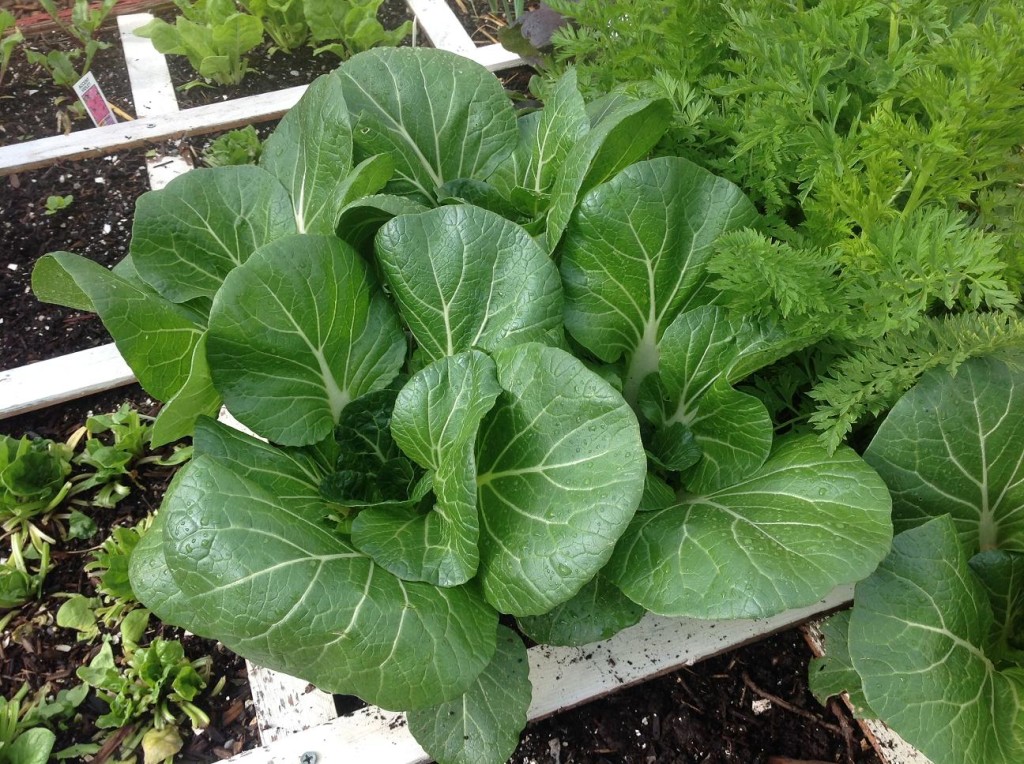 It got here quick. Right now I’m in the process of cleaning out many squares to put in all the fun summer stuff: tomatoes(6 kinds), peppers(4 kinds), more lettuce, more leeks, more poc choi, cucumbers, beans, basil, parsley, and cantalope. By Sunday the temperature is slated to be 34 at night so I’m holding off until Monday evening to plant. I’ve got everything started and ready to be transplanted. This is Joy Choi-another delicious variety of poc choi. Not quit as big as varieties I’ve grown before but equally delicious. Watch that weather forecast. Two big news items-first: my ebook on lettuce should be out in several weeks. It’s how to grow it during the hot summer months-virtually impossible. Second: I will be writing a biography on the inventor of the square foot garden system-Mel Bartholomew. A weekend trip to San Diego is coming up for me to get this started. From the looks of it this should be a fairly good sized book. I’m thinking a year to finish it but I could be wrong. I’ve never done something like this before. What do you think about that? Let me know….
It got here quick. Right now I’m in the process of cleaning out many squares to put in all the fun summer stuff: tomatoes(6 kinds), peppers(4 kinds), more lettuce, more leeks, more poc choi, cucumbers, beans, basil, parsley, and cantalope. By Sunday the temperature is slated to be 34 at night so I’m holding off until Monday evening to plant. I’ve got everything started and ready to be transplanted. This is Joy Choi-another delicious variety of poc choi. Not quit as big as varieties I’ve grown before but equally delicious. Watch that weather forecast. Two big news items-first: my ebook on lettuce should be out in several weeks. It’s how to grow it during the hot summer months-virtually impossible. Second: I will be writing a biography on the inventor of the square foot garden system-Mel Bartholomew. A weekend trip to San Diego is coming up for me to get this started. From the looks of it this should be a fairly good sized book. I’m thinking a year to finish it but I could be wrong. I’ve never done something like this before. What do you think about that? Let me know….
[ois skin=”below post”]
Tips for starting a container herb garden: A guest article
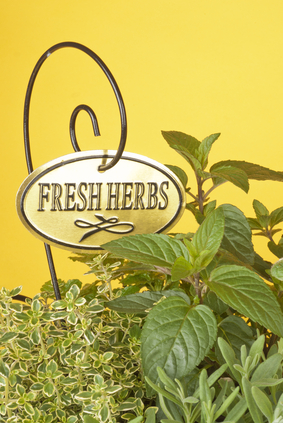
Fresh herbs are one of the most expensive items you can purchase at the grocery store. And what’s more, you have to buy them in bunches. But what if you just need a dash of rosemary or a sprig of thyme? Rather than buy overpriced herbs that might rot away in your refrigerator – unless you take the time to dry them – consider starting an herb container garden. You’ll have fresh herbs at your fingertips every time you cook. Here are a few tips to help you get started.
Choose a Sunny Location
Your herbs will grow more leaves if you put your container herb garden in a sunny location with some late afternoon and early evening shade. Herb gardens are best kept near a water source and as close to your house as possible. By putting your herbs in a convenient space, they will be easier to care for and to collect. Placing a long, rectangular potting container along your window sill will give you even easier access to your herbs.
Large Pots and Good Drainage
For people who love to cook regularly with their fresh, garden herbs, consider using large pots with good drainage instead of dealing with a bunch of small pots with one plant each. A 12 inch pot, for example, can hold about three to four plants. Be sure to check the bottom for adequate drainage holes.
Plant Herbs That Like Similar Conditions
Next, you’ll want to plant herbs that enjoy similar conditions. For example, if your palate prefers the spices of the Mediterranean, you can plant Thyme, Sage, and Rosemary together. Oregano, Lavender, and Marjoram are also a good mix. All of these plants like lots of sunlight and soil that’s on the drier side.
Use Top Notch Potting Mix
Grab a bag of potting mix, also known as growing medium, instead of potting soil. Container herbs grow best in potting mix because of its sterility and its ability to simultaneously retain moisture and aerate. You’ll have to add your own fertilizer to the potting mix and look for potting mix that contains some or all of the following.
* sand
* fine pine bark
* peat moss
* vermiculite
* perlite
Use Just Enough Water
It’s important not to use too much water or not enough water in your herb container garden. If you use too much water, you can cause fungus growth, pest problems such as gnats and root rot. On the other hand, too little water can cause your herbs to wilt. Wilting can stunt or even kill a plant.
You should only water your herb container garden when needed. To determine this, stick a finger into the plants’ potting mix, about 2 to 3 inches down. If it feels wet, don’t water. If it feels dry, water. Also keep in mind that young, small plants require less water than their mature counterparts.
Herb container gardening is a rewarding and economically smart way to add fresh, healthy herbs to your favorite favorite recipes. By following these tips and starting your herb garden today, you’ll add a touch of healthy living to your life.[ois skin=”below post”]
